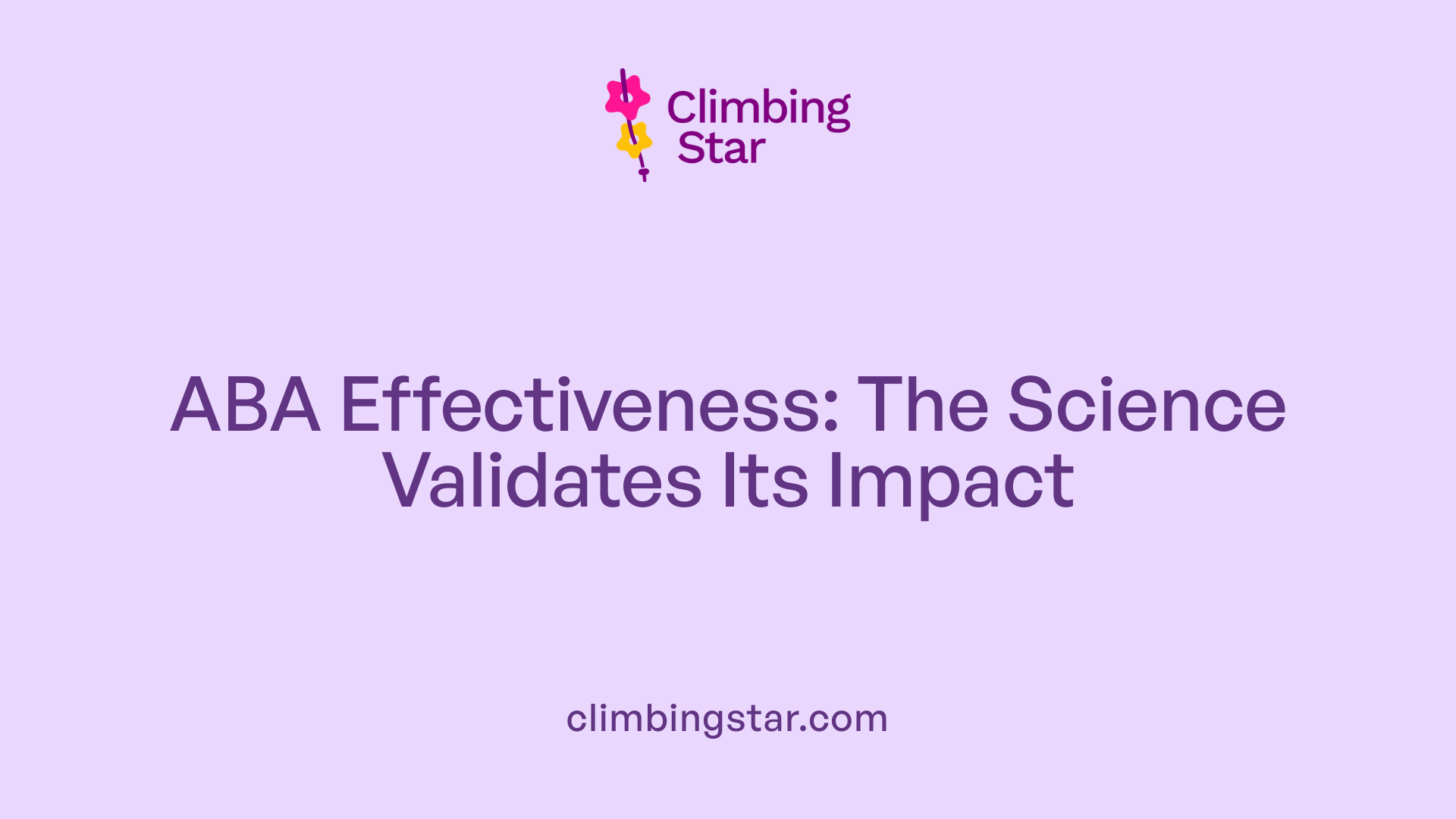Understanding Autism Through Behavior Analysis
Raising a child with autism presents unique challenges and opportunities. Among the various therapies available, Applied Behavior Analysis (ABA) stands out as a scientifically validated approach that helps children with autism develop crucial skills and adapt more effectively to their environments. This article explores ABA therapy in depth, the professionals who provide it, the evidence supporting its use, common concerns, and practical guidance for families seeking support.
What is ABA Therapy and How Does It Help Children with Autism?

Definition of ABA Therapy
Applied Behavior Analysis (ABA) therapy is a science-based approach designed to understand and influence behavior by examining its connection to the environment. In the context of autism treatment, ABA helps children acquire skills and reduce behaviors that may hinder learning or social interaction.
Its Scientific Foundation
ABA is rooted in behaviorism learning theory, focusing on how behavior is learned and maintained. It uses objective data, analyzing antecedents (what happens before a behavior), the behavior itself, and consequences, to modify behaviors effectively.
Key Objectives in Autism Treatment
The therapy aims to increase helpful behaviors such as communication, social skills, attention, memory, and academics, while decreasing behaviors that interfere with learning or safety. The goal is to enhance independence and quality of life.
How Behavior Is Analyzed and Modified
Through careful observation using the ABC model (Antecedent-Behavior-Consequence), therapists identify triggers and outcomes of behaviors. Positive reinforcement is a primary method, rewarding desired behaviors to encourage their recurrence. Undesirable actions are typically ignored or redirected rather than punished.
Types of ABA Teaching Methods
Prominent teaching styles include Discrete Trial Training (DTT), which breaks skills into small, teachable steps with reinforcement, and Pivotal Response Training (PRT), which focuses on natural settings and pivotal skills like communication initiation. These methods can be adapted to the child's learning style and preferences.
Customization of Therapy Plans
ABA programs are individualized, crafted by board-certified behavior analysts (BCBAs) based on each child's strengths and needs. They involve setting meaningful goals across areas such as self-care, play, motor skills, and academics. Progress is regularly tracked through data collection and sessions are adjusted accordingly to maximize effectiveness.
| Aspect | Description | Example/Details |
|---|---|---|
| Scientific Foundation | Study of behavior-environment interaction | Uses ABC analysis to modify behavior |
| Objectives | Increase positive, decrease harmful behaviors | Enhance communication and social skills |
| Behavior Modification Methods | Positive reinforcement, ignoring negative behaviors | Reward systems for language use |
| Teaching Styles | Discrete Trial Training (DTT), Pivotal Response Training | DTT uses stepwise teaching; PRT emphasizes natural context |
| Personalization | Designed by BCBAs with individual goals | Tailored goals in communication, academics |
ABA therapy’s flexible, evidence-backed approach makes it a foundational treatment for many children with autism, effectively supporting developmental progress with sustained, individualized care.
Core Techniques and Methods Used in ABA Therapy

What are the core methods or techniques used in ABA therapy?
ABA therapy utilizes several fundamental techniques to promote meaningful behavior change. One of the primary methods is positive reinforcement, which involves rewarding desired behaviors to encourage their recurrence. This technique helps individuals build helpful skills while creating a motivating learning environment.
Prompting and prompt fading are used to initiate new behaviors. Prompts provide cues or assistance to perform a behavior, and over time, these prompts are gradually withdrawn to foster independence. For example, a therapist might guide a child’s hand initially, then reduce help until the child performs the behavior alone.
Another important technique is behavior chaining, which breaks down complex behaviors into smaller, manageable steps taught sequentially. This helps individuals learn multi-step tasks effectively by building each step upon the last.
Discrete trial training (DTT) is a structured teaching method that involves clear instructions, prompt delivery, response from the learner, and immediate reinforcement or correction. It is useful for teaching specific skills in a controlled setting.
On the other hand, naturalistic teaching approaches promote learning in everyday environments through child-led interactions, making skills more generalizable. This includes methods like pivotal response training, where the focus is on enhancing motivation and pivotal behaviors such as communication and social interaction.
ABA also incorporates modeling and extinction techniques. Modeling involves demonstrating desired behaviors for observational learning, while extinction reduces unwanted behaviors by no longer reinforcing them. These are often combined with redirection and script fading to improve social and functional skills.
Together, these core methods are personalized within an ABA program to address each individual’s unique needs, ensuring progress across communication, social, and daily living domains.
Qualified Professionals Behind ABA Therapy

Roles of BCBAs and RBTs
ABA therapy is delivered by a team of trained professionals, primarily including Board Certified Behavior Analysts (BCBAs) and Registered Behavior Technicians (RBTs). BCBAs are responsible for designing and overseeing individualized programs, setting goals, analyzing behavior data, and adjusting interventions as needed. RBTs work directly with clients, implementing therapy plans under BCBA supervision and providing hands-on support during sessions.
Educational Requirements
BCBAs typically hold at least a master's degree in behavior analysis, psychology, education, or a related field. RBTs usually have a high school diploma or equivalent and complete specialized ABA training. The rigorous education and training ensure professionals possess the knowledge to apply evidence-based techniques appropriately and effectively.
Certification Standards
Certification through the Behavior Analyst Certification Board (BACB) is a crucial standard for BCBAs and RBTs. This certification confirms they have met defined educational and practical experience requirements and demonstrate competency in ABA principles and ethical practices. Maintaining certification requires ongoing professional development and adherence to ethical guidelines.
Work Environment and Supervision
ABA providers often work in clinics, schools, or home-based settings. BCBAs supervise RBTs closely, ensuring therapy is personalized, safe, and ethical. This supervision includes regular observation, data review, and collaboration with families to optimize treatment outcomes.
Who provides ABA therapy and what qualifications do they typically have?
ABA therapy is typically provided by trained professionals such as BCBAs, BCaBAs, and licensed behavior therapists. They usually possess a strong educational background in psychology or behavior analysis, commonly holding a master’s degree. Certification from the BACB guarantees they meet professional standards and have completed specialized training. Many providers work within organizations focused on autism and behavior interventions, offering team-based, supervised care tailored to individual needs.
Scientific Evidence Supporting ABA Therapy Effectiveness

What evidence supports the effectiveness of ABA therapy for individuals with autism?
Scientific research robustly supports Applied Behavior Analysis (ABA) as an effective therapy for autism spectrum disorder (ASD). More than 20 well-designed studies and meta-analyses confirm that intensive, long-term ABA therapy can lead to significant gains in intellectual functioning, communication, daily living skills, and social functioning.
Research studies and meta-analyses
Research involving randomized controlled trials demonstrates that ABA interventions produce meaningful improvements across multiple domains. These studies report high effect sizes in IQ improvement, expressive language development, behavioral reductions, and enhanced social-emotional growth. Meta-analyses show that when families are involved, benefits are sustained over time, reinforcing ABA’s role as a foundational treatment.
Improvements in IQ, language, social skills
Children receiving ABA therapy often exhibit marked advancements in IQ scores, improved expressive and receptive language skills, and gains in social interactions. These improvements translate into better adaptive functioning and increased independence in daily life.
Importance of early and intensive intervention
Evidence consistently highlights that initiating ABA at an early age, with intensive and individualized programming, yields the greatest developmental progress. Early intervention capitalizes on neuroplasticity, setting a strong foundation for lifelong skills.
Recognition by health authorities
The US Surgeon General and the American Psychological Association recognize ABA as an evidence-based best practice for treating ASD. This authoritative endorsement further validates ABA’s efficacy and safety when appropriately delivered by qualified professionals.
Long-term benefits
Longitudinal studies indicate that the positive effects of ABA therapy extend into adolescence and adulthood. Individuals often continue to benefit from improved communication, social skills, and greater overall adaptive functioning, supporting ABA as a sustainable treatment approach for autism.
Addressing Challenges and Ethical Considerations in ABA Therapy
What are some common challenges or criticisms associated with ABA therapy?
Applied Behavior Analysis (ABA) therapy has faced several criticisms over time. Historically, the therapy was often intensive, requiring children to engage in 20 to 40 hours per week. This frequency can be overwhelming for both families and children. Critics also highlight concerns over rigidity, where therapy could be repetitive and suppress natural behaviors like stimming, aiming to make autistic children appear more neurotypical.
Ethical issues have arisen from past use of aversive or punishment-based methods. Modern ABA rejects these practices, focusing instead on positive reinforcement and individualized approaches that respect each child’s unique needs and strengths.
Concerns about rigidity and neurotypical focus
One major concern is that some ABA programs might prioritize conformity to neurotypical behaviors rather than embracing neurodiversity. This can unintentionally diminish the child’s individuality and comfort. To counteract this, contemporary ABA therapies emphasize tailoring goals to meaningful skills that improve quality of life without forcing children to abandon their natural expressions.
Importance of positive reinforcement and individualization
Effective ABA therapy uses positive reinforcement to encourage helpful behaviors, creating an encouraging and respectful learning environment. Each program is customized by a qualified behavior analyst (BCBA) to focus on skills important to the individual, balancing learning objectives with leisure and respecting the child's preferences.
Signs of safe versus unsafe ABA practices
Safe ABA programs avoid punishment and harsh interventions, instead promoting skill development with compassion and respect. Warning signs of unsafe ABA include use of punitive measures, lack of personal tailoring, forcing neurotypical behaviors, and sessions causing distress without progress.
Emotional well-being and client dignity
Ensuring emotional well-being and dignity is central to ethical ABA. This involves parental and professional monitoring, ongoing assessment, and involving the client in goal setting. Respecting neurodiversity and supporting autonomy helps maintain a therapy environment that is both effective and person-centered.
Accessing ABA Therapy: Practical Steps for Families and Caregivers
How can families and caregivers access ABA therapy for their loved ones with autism?
Families looking to access Applied Behavior Analysis (ABA) therapy typically begin by obtaining a formal diagnosis of autism spectrum disorder (ASD) from a qualified healthcare provider. This diagnosis often leads to a referral for behavioral health treatments, including ABA therapy, ensuring that the child receives appropriate intervention.
Exploring insurance coverage is a crucial next step. Many insurers, including Medicaid plans like Medi-Cal, cover ABA therapy when it is deemed medically necessary, especially for children under the age of 21. Understanding the specifics of your insurance plan, including the extent of coverage and any requirements, can help in planning for therapy sessions.
Beyond insurance, families can turn to autism organizations for support. Groups such as Autism Speaks, the Autism Spectrum Disorder Foundation, and Autism Care Today provide valuable resources including financial grants, scholarships, and assistance with equipment or therapy costs. These organizations can be instrumental in bridging funding gaps for families.
Searching for ABA providers involves evaluating options carefully. Families should ask about staff qualifications, experience, training, safety procedures, session structure, goal setting, and progress evaluation to find the right fit. Local Regional Centers and school-based programs often assist in coordinating ABA services, sometimes leveraging public funding to support therapy access.
For families facing financial challenges, applying for grants or financial assistance from autism-focused organizations can ease the burden of therapy costs. These resources enable ongoing participation in ABA therapy, which is vital for meaningful progress in communication, social skills, and daily living.
By taking these practical steps—securing a diagnosis, understanding insurance benefits, utilizing support organizations, carefully selecting providers, and seeking financial assistance—families and caregivers can effectively access ABA therapy to support their loved ones.
Integrating ABA with Other Autism Therapies and Supports
How are developmental approaches used alongside ABA?
Developmental approaches, such as speech and language therapy and occupational therapy, are often combined with ABA to enhance communication, social, and functional skills. These therapies complement ABA by targeting specific developmental milestones and helping children generalize their skills across varied environments.
What are some educational strategies used with ABA?
Educational treatments like the TEACCH approach leverage structured routines and visual supports within classroom settings to facilitate learning for individuals with autism. Incorporating TEACCH alongside ABA can create a supportive educational framework that builds on behavioral progress with clear organization and predictability.
How do social-relational methods support ABA therapy?
Social-relational methods such as DIR (Developmental, Individual differences, Relationship-based model), "Floor Time," Relationship Development Intervention (RDI), Social Stories, and social skills groups focus on fostering social skills and emotional connections. These approaches, often involving parents or peer mentors, can complement ABA by promoting meaningful interpersonal interactions and relationship building.
What psychological and pharmacological considerations are important?
While ABA targets behavior and skill acquisition, psychological therapies like cognitive-behavior therapy (CBT) can assist individuals with autism in managing anxiety and depression. Pharmacological treatments may address co-occurring symptoms such as high energy or mental health challenges but require careful supervision as no medications treat core autism symptoms.
How should complementary therapies be approached alongside ABA?
Families may explore complementary therapies—including special diets, herbal supplements, animal or arts therapy, mindfulness, and relaxation techniques—to support overall well-being. However, these should be used cautiously and discussed with healthcare professionals to ensure safety and coordinate effectively with evidence-based ABA programs.
Ensuring Safe and Effective ABA: The Role of Families and Professionals
Parental Involvement and Session Monitoring
Active parental involvement is essential in ABA therapy. Parents and caregivers should participate in sessions whenever possible, observe interventions, and communicate regularly with therapists. This engagement helps ensure the therapy aligns with the child's unique needs and maintains a supportive environment.
Evaluating Progress and Adapting Goals
Progress is closely monitored using data collected during sessions. Qualified professionals continuously assess improvements and challenges, adjusting goals to fit the individual's evolving abilities. This dynamic approach maximizes the effectiveness of the therapy and addresses new areas of growth.
Identifying Red Flags in Therapy
Warning signs of unsafe or ineffective ABA include the use of punishment or negative reinforcement, lack of personalization, and an exclusive focus on imitating neurotypical behaviors without skill development. Also, if sessions cause distress or show no meaningful progress, families should question the approach and seek alternative strategies.
Maintaining Respect for Neurodiversity
Safe ABA emphasizes positive reinforcement and respects the child’s neurodiversity. Therapists tailor interventions to promote helpful skills and recognize each child's strengths, rather than trying to force conformity to typical developmental norms.
Balancing Therapy with Child’s Leisure and Comfort
Therapy should be balanced with leisure activities and comfort to support a child's overall well-being. Ensuring that interventions do not overwhelm or exhaust the child helps maintain motivation and a positive attitude toward learning.
| Aspect | Importance | Description |
|---|---|---|
| Parental Involvement | High | Supports therapy alignment and safety |
| Progress Evaluation | Critical | Enables goal adaptation based on data |
| Recognizing Red Flags | Vital | Protects from harmful practices |
| Respecting Neurodiversity | Fundamental | Encourages strengths and individuality |
| Balancing Therapy and Leisure | Essential | Ensures child’s comfort and sustained engagement |
Empowering Families with Knowledge and Resources
Raising a child with autism requires a multifaceted approach, combining effective interventions, caring professionals, and empowered families. Applied Behavior Analysis therapy remains a cornerstone in supporting children’s development through its scientifically backed methods and personalized programs. By understanding the core principles, the qualifications of providers, and the evidence supporting ABA, families can make informed decisions about care. Awareness of challenges and ethical concerns helps ensure therapy respects the dignity and emotional well-being of children. Accessing services may require navigating referrals, insurance, and community resources, but support is available. Complementing ABA with other therapies can address the wide range of needs each child has. Ultimately, collaboration and vigilance between families and professionals create the safest, most effective environment for children with autism to thrive and reach their potential.
References
- Applied Behavior Analysis (ABA)
- Applied Behaviour Analysis (ABA) and autistic children
- Treatment and Intervention for Autism Spectrum Disorder
- The effectiveness of applied behavior analysis program ...
- The effectiveness of applied behavior analytic interventions ...
- Efficacy of Interventions Based on Applied Behavior ...
- Applied Behavior Analysis (ABA)
- Introduction to Applied Behavior Analysis: ABA 101







